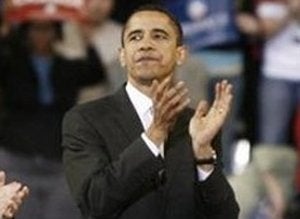
December 2, 2008, Philadelphia - The historic significance of Independence Hall was not lost on the forty-eight governors who gathered here today with President-elect Barack Obama and Vice President-elect Joe Biden, for an unprecedented meeting about the economy. In 1776, when the Founding Fathers gathered at what was the Pennsylvania State House from each of the thirteen colonies, Americans faced a crisis that had taken them to the precipice of war. Today, the United States is at an economic precipice unlike anything since the Great Depression, exacerbated by recklessness on Wall Street and two wars abroad. On November 4, the American people once again made their voices heard by rejecting the failed policies of George W. Bush, and electing Barack Obama President.
In a demonstration of leadership, and with an understanding of history,
President-elect Obama convened the Independence Hall meeting to discuss his economic recovery package and listen to the governors' recommendations for how the federal government can work with state and local governments to help meet economic challenges in the difficult months ahead. For example, Obama wants to ensure that states can continue to provide social safety nets, like food stamps and Medicaid, to needy citizens even in this economic downturn. As the colonists united in spite of their differences in 1776, governors from both political parties responded to the President-elect's invitation and joined him in Philadelphia. For one hour and forty-five minutes, Obama and Biden talked, took questions from the governors, and listened.
"We were not here to ask for money," said Pennsylvania Governor Ed Rendell, chairman of the National Governors Association and host of the meeting. "This meeting was requested by President-elect Obama. We were here to voice our concerns and needs and to offer our help with the recovery plan," he said. "There will be a significant increase in infrastructure programs, which build jobs. In this economy, there will be increased pressure on safety net programs and states will need some help in funding them."
The Infrastructure Revitalization Program, which will rebuild the nation's crumbling infrastructure and create new jobs met with the governors' approval. The figure for the "Ready-to-go" infrastructure program is 136 billion dollars. "If we can cut through some of the bureaucratic process, we can have more "Ready-to-go" programs," said Rendell. He explained that infrastructure programs create jobs in such related industries as asphalt, lumber and steel.
"California is at the forefront of the "Ready-to-go" Infrastructure Revitalization Program," said California Governor Arnold Schwarzenegger, "We made a commitment to the infrastructure in 2006. Ten billion dollars will be spent on a high speed rail." Schwarzenegger pointed out that the US is behind Europe in building a high speed rail transportation service. "We need the high speed rail," he said, "It builds jobs."
Above Independence Hall and the words "We the People" on the Constitution Center that faces it across the mall, the sun came in and out from behind the clouds, rendering the sky alternately sunny and gray, an apt symbol of how Americans feel today-- optimistic about the promise of the Obama administration and anxious about the economic forecast. Yet, the morning light and the wintry temperatures were invigorating, lending a sense of renewal to the gathering of governors, staff and media. The fact that Obama is committed to working with state and local governments built confidence.
"The idea of a bubble in Washington doesn't exist anymore," said New York Governor David Patterson. "The federal government turned its back on Medicaid in the last eight years. This President...is open to the states. Optimism--from being heard and listened to by the President-elect--can help to stimulate the economy."
In addition to the infrastructure, the governors support Obama's call for alternative energy sources. Iowa Governor Chet Culver addressed the importance of building an energy grid, especially in the mid-west and west, to carry wind and solar energy. In order to achieve this, Culver said, "We need to cut through bureaucratic hurdles," a theme echoed by the governors.
While most economists agree that Obama will need an aggressive economic recovery program to stimulate the economy, there are some naysayers, among them South Carolina Governor Terry Sanford and Minnesota Governor Tim Pawlenty, both prospective Republican presidential candidates for 2012 or 2016. "Can we solve the problem of debt with more debt," Sanford asked. "There are very serious questions about whether this will make a difference."
"We had a ten trillion dollar deficit before the collapse. That's thirty-five thousand dollars per citizen," said Pawlenty. "We're visiting those obligations on our children and grandchildren."
"President Obama still has the goal to cut the deficit," said Rendell, "but even economists like Felstein agree with the need for a stimulus package. This is the best of all financial recovery plans. One billion in spending will create jobs."